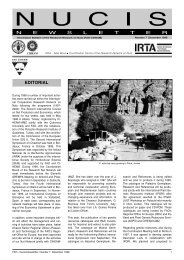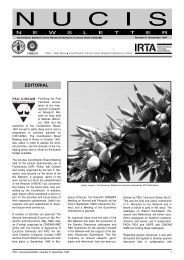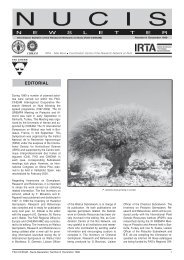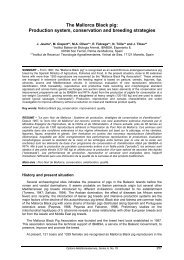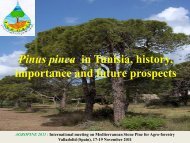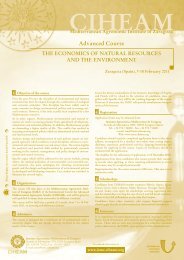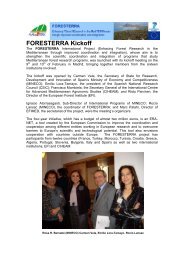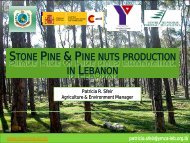NUCIS number 12. September 2004. 52 pages (full ... - IAMZ - ciheam
NUCIS number 12. September 2004. 52 pages (full ... - IAMZ - ciheam
NUCIS number 12. September 2004. 52 pages (full ... - IAMZ - ciheam
- No tags were found...
Create successful ePaper yourself
Turn your PDF publications into a flip-book with our unique Google optimized e-Paper software.
Figure 2.- New carob tree planting in Yibasancounty (Sichuan province)Figure 3.- Research group that visits the carobseed plantations in several areas of the Xichangcounty (Sichuan province)Figure 4.- Carob tree reforestation in degradedareas of Sichuan provincewere used: direct sowing in the field andsmall plants with containers. The last methodwould be the most suitable and to beused in the future.The necessity to know the possibilities ofdevelopment of the carob tree in China,as an answer to the new expectations generatedby this species, fostered the realizationof this technical collaborationbetween China and Spain (Fig. 3).ECOLOGYThe edaphoclimatic conditions of the Chineseareas where the carob has been introduced,Sichuan, Yunnan and Guangxiprovinces placed in the south, are differentfrom those of the Mediterranean Basinto which carob is well adapted. It highlightsthe great climatic variability, with altitudesof 800-1000 m above sea level,minimum temperatures of 0 or -1ºC andmaximum of 40ºC, although there is a biggap of temperature between day and night(about 10 ºC), and rainfall of 700-800 mmin the county of Xichang (Sichuan) and,higher in the other two provinces (Yunnanand Guangxi), about 1000 mm, distributedbetween June and <strong>September</strong>. Thecarob was planted on hilly lands and thesoils in overall are not very deep, clayloam,grey-brown colours, with neutral orslightly acid pH (6-7) and low levels ofphosphorus and calcium (Fig. 4).In the Mediterranean countries (Spain,Italy, Portugal, Greece, Morocco, Tunisia,etc.), the carob grows well in warm temperatureand subtropical areas, with altitudesbelow 600 m above sea level, lowrainfall in summer (300-500 mm/year),and tolerates hot and humid coastal zones.It can only withstand light frost; temperaturesbelow –4ºC can damage youngtrees and flowers of mature trees. Carobcan adapt to a wide range of soil typesfrom poor sandy soils and rocky hillsidesto deep soils, but they cannot withstandwaterlogging. In the Mediterranean Basincarob generally grows in marginal, calcareousand basic soils.CROP DEVELOPMENT RESTRICTIONSThe areas where the carob tree has beenintroduced in China, in the case of the Sichuanprovince, the following remarkscan be highlighted:The areas where the carob seeds havebeen planted are hilly, long away from thecoast, with high altitudes above sea level,high rainfall (800-1000 mm and concentratedon three summer months) and withvery poor soils, neutral or slightly acidpH, and these conditions are quite differentfrom the Mediterranean countries.Temperatures of the Yibasan and TongAnareas are warm and more similar to caroboriginal areas of Mediterranean Basin.Pests: Severe damage is caused inyoung trees by rabbits and some nativeants that gnaw trunks and new shoots.Diseases: High rainfall, concentrated onsummer months, can cause waterloggingproblems in young carobs and later promotefungus attacks of Phytophtora, inthe neck of the tree, and Oidium in theleaves of the most sensitive carob seedtrees.Pollination: the carob is a trioecious specieswith male, female and hermaphroditeflowers borne on different trees. It bloomsin summer-autumn and it seems to bemainly pollinated by insects, but also bywind. High rainfall and relative humidity inthe rainy summer season, could increasepoor fruit set during the pollination time(mainly the period that overlaps withblooming time).Mechanical harvesting: currently this factoris not very important because there islarge manpower and its cost is low.RESEARCH AND DEVELOPMENTNEEDSResearch and development carob worksin the Chinese Academy of Forestry isvery limited, outstanding some nurseryworks (seed germination, planting methods,etc.). Future work would have toassess the performance of the seedlingsplanted in the three Chinese provinces(about 100.000 seedlings) that adapt betterto the new environmental conditions,and select seedlings from more vigorouscultivars, female and hermaphrodite sexes,tolerant to diseases (Oidium), earlybearing and fruits with good quality. Laterit would be necessary to bud the besttrees on seedlings and to introduce themin collections and comparative trials to finishtheir agronomic and commercialevaluation. These works should be carriedout within the new agroforestry systemsframework in which the carob couldsolve reforestation problems in degradedareas and its bean production used bothfor human and animal feeding (sheep,goats, pigs, cows, horses, etc.). A climaticand soil characterization of the possiblelocations for this specie would also beinteresting, with the purpose of beingable to define its potential expansionarea in China, avoiding future problemsof lack of crop adaptation.CONCLUDING REMARKSThere are some favourable aspects onthe development of the carob cultivationin China, large surfaces, large manpowerfor harvesting, potential agroforestryuses, being able to use their productionboth for human and animal feeding. Onthe other hand, it is necessary to choosewell the growing areas, which should bewindy, with little risk of frost, and the cultivarsto be recommended should adaptwell to Chinese growing conditions becausethey are different to those of theiroriginal areas (Spain, Italy, Portugal,etc.). Based on the previously described,the carob tree in China it can be consideras an alternative crop in dry land areaswith warm or subtropical climates for diversificationon the agroforestry farms.ACKNOWLEDGEMENTSThese results emerged from a technicalvisit to China by the first author in December2003, which was supported by theChinese Academy of Forestry, Beijing(China).J. Tous 1 , and J. Chunqian 21Institut de Recerca i Tecnologia Agroalimentàries(IRTA), Dept. d’Arboricultura Mediterrània,Centre Mas Bové. Apartat 415. 43280Reus, Spain.2International Farm Forestry Training Center.Chinese Academy of Forestry, Beijing 100091,China.E-mail: joan.tous@irta.es40 FAO-CIHEAM - Nucis-Newsletter, Number 12 <strong>September</strong> 2004



